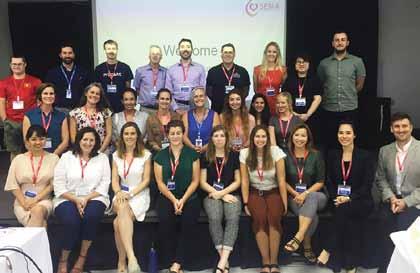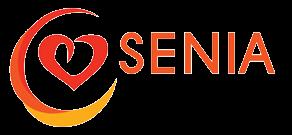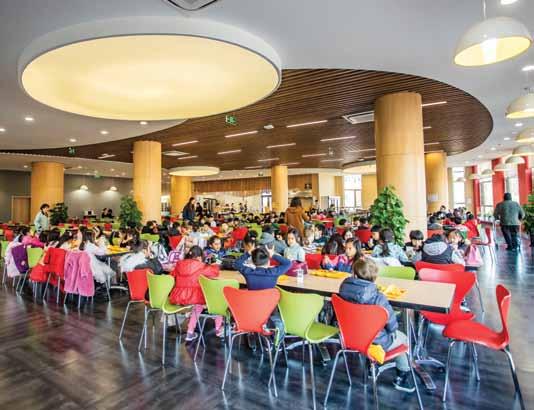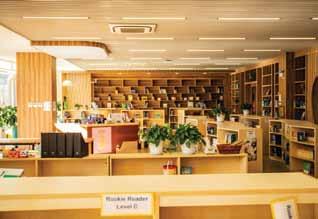
6 minute read
SENIA Expands Worldwide
SENIA Expands Worldwide By Lori Boll
SENIA Vietnam’s first meeting
In 2002 a small group of special educators met at an international school in Beijing, China, to determine ways to advocate for children with learning differences. They named themselves SENIC (Special Education Network In China) and began holding annual gatherings for teachers, parents, and professionals in the area of special education. Eventually, they expanded throughout Asia and renamed themselves SENIA (Special Education Network in Asia).
From this humble beginning, SENIA has expanded in many directions. EARCOS and SENIA partnered to hold joint conferences every three years. This helps extend the reach of the SENIA mission to all teachers in the EARCOS region, and the EARCOS organization has been a tremendous support to the group. Last year, SENIA broadened its reach outside of Asia, making it a worldwide organization with regional chapters in South America, Europe, the Middle East, Africa, and Asia. While the organization grew globally, it also strengthened roots in Asia and beyond with more local chapters coming on-line. These 19 local chapters are doing remarkable work in their communities from holding conferences to hosting provider fairs and running parent support group meetings. In the last few months, well established local chapters such as Thailand, Beijing, and Malaysia put on conferences serving 80-120 members of their communities. New chapters in Cambodia and Vietnam held their first meetings, and SENIA Japan formed a new board.
The SENIA Doha chapter recently hosted a provider fair. Selina Collins of the Doha board explained, “...Members had the opportunity to meet with new service providers, ask questions about specific services, and connect with organizations (and members) who can provide in-school support for underserved students.”
The expansion also extended into the schools with the growth of the SENIA Teacher Representative initiative. This initiative launched in 2016 with the vision that these representatives would be the conduit linking the SENIA Board with their respective schools. Three years later, 101 schools have recognized the importance of this role, and it has transformed from being an information source to someone who advocates and connects their schools with SENIA International, SENIA Local Chapters, and inclusive PD in the region. Kate Balsamo, the chairperson of the SENIA board, remarks, “Our SENIA TR’s continually advocate for the needs of diverse learners, and they are committed to advancing best practices in education for all students.”
Tanya Farrol attended the very first meeting in Beijing and is now a board member of SENIA. “From this grassroots beginning, SENIA emerged and has maintained its vision and mission over the past 17 years. It has been thrilling to be part of SENIA’s growth and development of fostering inclusive practices around the world.”
SENIA’s next annual conference will be February 21-23rd at the International School Manila. If you are interested in becoming part of the inclusive movement in international schools, this would be a great place to start.
For more information, go to the SENIA website. www.seniainternational.org
SENIA’s Vision: To live in an inclusive world where every individual is supported, resources are accessible, potential is maximized, and action is inspired.


Campus Development Construction Completed: Expanding Facilities and Building Community
By Miles McFall, Assistant Principal of the Dalian Huamei Bilingual School



Ready, Set…
Let’s build a bilingual school! Where do we start? When the decision to expand the Dalian American International School program offerings to include a bilingual school for Chinese nationals was made in 2017, we knew there would be much to do. To form the Dalian Huamei Bilingual School, board members, administration and teachers traveled around Asia visiting schools, asking questions and reviewing research to see what the landscape was and to find the best path forward. Thankfully, the collaborative and supportive environment of ISS schools meant that our colleagues in other institutions were honest and forthcoming.
Now was the hard part. Putting together all we had seen into a cohesive program to meet the needs of our community. And so the conversations started. What do we value? What do we mean when we say we’re a ‘bilingual’ school? How do the influences of culture on individuals and systems inform our planning? What will the similarities and differences be between our international and bilingual school? Anyone who has participated in the work of starting a new school knows the myriad of questions and plans that need to be made and changed as issues arise.
Most salient of concerns was our community’s desire to keep the defining elements of DAIS throughout the expansion. In a time when ‘Community’ is such a buzzword, everyone was almost embarrassed to use it, but stakeholder feedback showed it was true that at DAIS the idea of community has pervaded the campus from its humble roots over a decade ago. Keeping that close-knit neighborhood feel as our campus expanded by hundreds of students and families was first and foremost in our minds. In identifying the needs of our community, we opened amazing new student housing, athletic facilities, performance space and meeting rooms, as well as the largest academic building on our campus. Our new, purpose-built academic building became home to the Dalian Huamei Bilingual School, which opened its doors to Chinese national and international students in grades one through six. These new spaces allowed for expansion without impinging on classroom, athletic or living spaces of our former students and families.
A New Chapter
Despite the previous years of designing, planning and constructing the new building, it really wasn’t brought to life until faculty and staff worked for weeks to create a warm, welcoming, multilingual environment for new students. As nervous and excited students and parents streamed in to begin building a new community, we committed to fostering the same personal relationships that made DAIS successful. And what better way to bring a community together than with a library!
Designed to welcome DHBS parents, faculty and students to a school devoted to social, academic and personal growth, the library has expanded the DAIS library circulation to over 20,000 books distributed between the three libraries on campus. With a school founded on the development of bilingualism, biliteracy and socio-cultural competence, having a library stocked with monolingual books in English and Mandarin as well as dual languages supports the bilingual people we strive to help our students become.
In the months since our first day, it was been gratifying to watch personal connections form as ‘new students’ became classmates and friends. As planned, our spacious new cafeteria designed to seat over 450 people serves as a common meeting place for DAIS and DHBS elementary and middle school students. What we didn’t expect was that on any given day, it’s not uncommon to see faculty and staff with students from each division sharing meals and laughs.
The expanded side-by-side art classrooms have been busy producing creative, original student work to help decorate the space. It’s gratifying to see our multicultural school identity coming through with bold self-portrait paintings contrasting elegant Chinese calligraphy and watercolors. The experience continues as both the Chinese and English music classes prepare for both a winter concert and spring festival celebration. It’s not every day that one hears both Jingle Bells and the gujung from different directions in the same hall. These distinct cultural offering are evidence that as our community continues to diversify, the benefits are shared by everyone.
The work Continues
As DHBS continues expanding, there is yet much to accomplish. While previous planning provided us a foundation, there are many exciting innovations ahead. Echoing discussions happening at a global-scale, our faculty, staff and students are coming together over conversations about navigating cultural differences in understanding, learning and language. Intentionally building bridges between languages to support biliteracy, creating multilingual learning spaces using translanguaging and helping guide students in reflective practices around language choices has been as rewarding. We look forward to the day when our students carry our sense and appreciation of community out to include even more potential neighbors.










